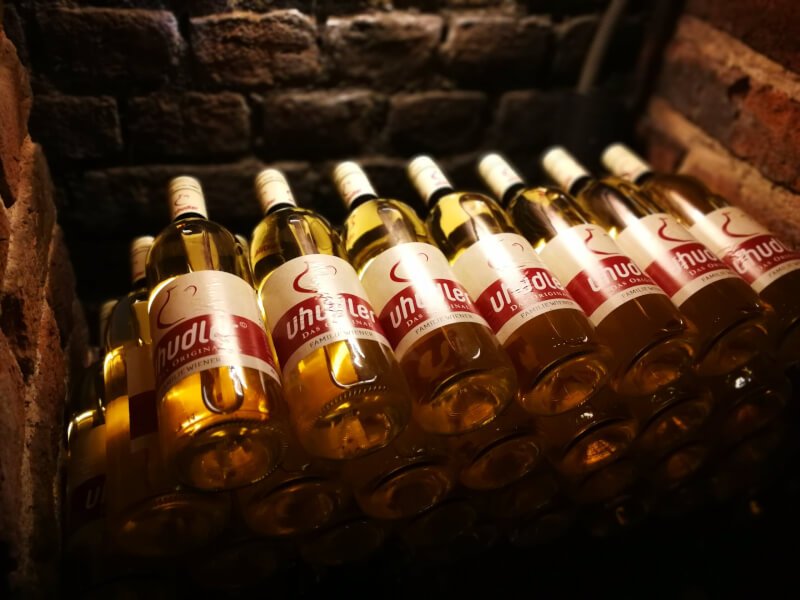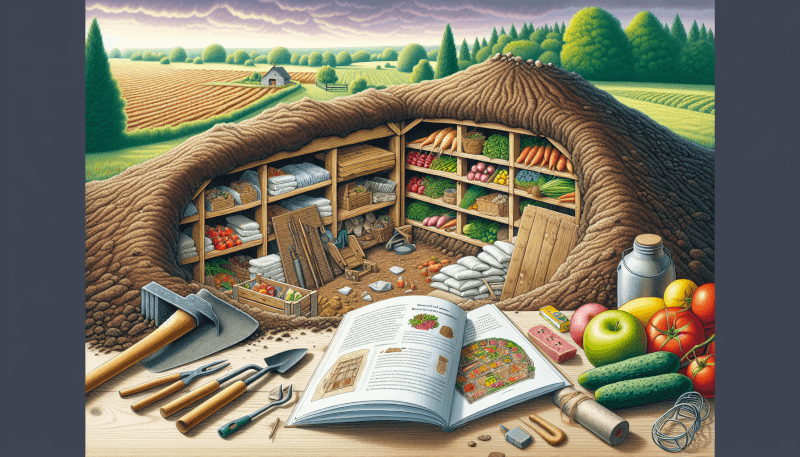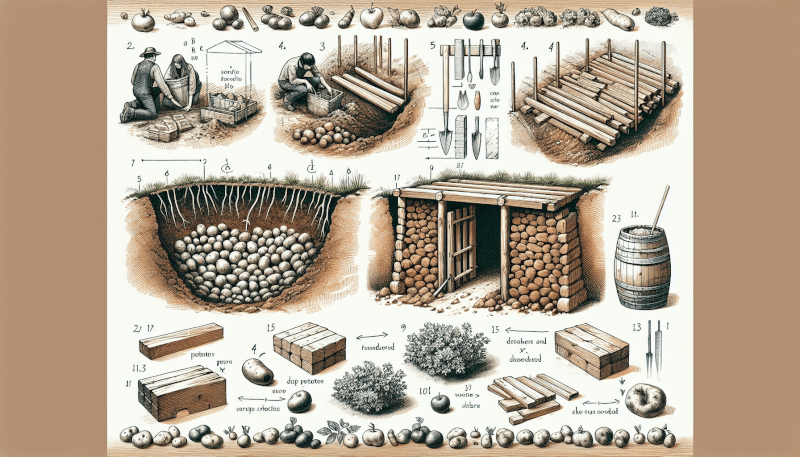Imagine having a secret oasis right in your backyard, where your fresh produce and preserves can be stored throughout the year. In this article, you will discover a step-by-step guide on how to build a root cellar for food storage. By following these simple instructions, you’ll be able to create a practical and eco-friendly solution to keep your fruits, vegetables, and preserves fresh and flavorful without the need for modern refrigeration. So, let’s roll up our sleeves and get ready to learn how to transform your garden into a sustainable source of food all year round!

Choosing the Right Location
Assessing the Climate and Temperature
When selecting the location for your root cellar, it is essential to consider the climate and temperature of your area. A root cellar is designed to provide a cool and stable environment for storing food, so you want to choose a spot that offers natural insulation from the outside elements. Look for areas with consistent temperatures and minimal fluctuations throughout the year.
Considering Accessibility and Convenience
Another important factor to keep in mind is accessibility and convenience. You want your root cellar to be easily accessible from your home, garden, or wherever you’ll be storing the majority of your food. Consider proximity to your kitchen or other areas where you frequently access your preserved food. Additionally, ensure that the location is convenient for transporting produce and supplies to and from the cellar.
Ensuring Proper Ventilation
Proper ventilation is crucial for maintaining the ideal storage conditions in your root cellar. You want to ensure there is adequate airflow to prevent moisture buildup and the growth of mold or mildew. You can achieve this by implementing ventilation openings or using ventilation pipes or ducts. Good ventilation also helps control the temperature and humidity levels inside the cellar, preventing spoilage of stored food.
Planning and Designing the Root Cellar
Understanding the Basics of Construction
Before embarking on building your root cellar, it is important to understand the basics of construction. Research different construction methods and materials suitable for your desired design and the climate of your area. Familiarize yourself with the necessary tools and techniques to ensure a successful and durable root cellar.
Determining the Size and Layout
The size and layout of your root cellar will depend on various factors, including the amount of food you plan to store, available space, and your specific storage needs. Take inventory of the types and quantities of produce you typically preserve, and plan the cellar accordingly. Consider storing shelves, space for hanging cured meats, and bins for storing root vegetables. Sketch out a layout to optimize space and ensure easy access to different areas of the cellar.
Gathering Necessary Tools and Materials
To ensure a smooth construction process, gather all the necessary tools and materials before starting your root cellar project. Some essential tools you may need include shovels, hammers, saws, levels, and screwdrivers. As for materials, consider the type of foundation, insulation, and construction materials suitable for your specific design. Plan your materials list accordingly, accounting for the size and layout of your root cellar.
Excavation and Site Preparation
Preparing the Site for Construction
Once you have determined the location for your root cellar, you need to prepare the site for construction. Clear any vegetation or debris from the area and mark the boundaries of the cellar. Take any necessary measurements and ensure the site is level and well-drained. It is crucial to have a solid foundation for your root cellar to ensure its stability and durability.
Clearing and Leveling the Ground
Before digging the foundation, clear the ground surface and level it as much as possible. Remove any rocks, tree roots, or other obstacles that may interfere with the construction process. Leveling the ground will help ensure a stable foundation and make the excavation process smoother.
Digging the Foundation
With the site prepared, it’s time to start digging the foundation of your root cellar. The depth and size of the foundation will depend on your specific design and needs. Excavate the ground carefully, following the layout and measurements you planned. Take into account the proper height for the foundation to ensure adequate headroom inside the cellar. Remember to reinforce the foundation walls as necessary to provide stability to the structure.
Building the Root Cellar Structure
Constructing the Walls
After the foundation has been prepared, it’s time to construct the walls of your root cellar. Depending on your chosen construction method, you may use materials such as concrete blocks, stones, or wood. Ensure that the walls are sturdy and properly insulated to prevent heat transfer from outside the cellar. Follow your planned layout and measurements to create a durable and efficient structure.
Building the Floor and Roof
Once the walls are in place, it is essential to build a solid floor and a reliable roof for your root cellar. The floor should be raised to prevent moisture seepage and adequately insulated to maintain a cool temperature. When constructing the roof, consider using materials that provide proper insulation and protection from the elements. Ensure that both the floor and roof are tightly sealed to maintain the desired storage conditions inside the cellar.
Installing Proper Insulation
Proper insulation is crucial for maintaining the temperature and humidity levels in your root cellar. Insulate the walls, floor, and ceiling using materials like foam board, fiberglass, or spray foam. Insulation helps prevent heat transfer and keeps the environment stable, protecting your stored food from spoilage. Make sure to insulate all areas of your cellar adequately to maximize efficiency and maintain optimal storage conditions.

Creating an Efficient Ventilation System
Understanding the Importance of Ventilation
A well-designed ventilation system is vital for maintaining proper airflow and preventing moisture buildup inside the root cellar. It helps regulate temperature and humidity levels, reducing the risk of spoilage. Adequate ventilation also helps control odors and prevents the growth of mold or mildew. Understanding the importance of ventilation will ensure the long-term preservation of your stored food.
Installing Ventilation Openings
To create a efficient ventilation system, you need to install ventilation openings in your root cellar. These can be vents or windows that allow fresh air to enter while letting stale air escape. Place the openings strategically to promote efficient airflow. Consider incorporating mesh screens to prevent insects or rodents from entering while still allowing air circulation.
Placing Ventilation Pipes or Ducts
In addition to ventilation openings, you may also consider installing ventilation pipes or ducts to create a more controlled airflow. These pipes or ducts can be connected to the ventilation openings and can help channel air through specific areas of the cellar. You can use fans or natural convection to enhance airflow and ensure an ideal storage environment for your preserved food.
Installing Lighting and Electrical Connections
Determining Lighting Requirements
Proper lighting is crucial for easy accessibility and organization within your root cellar. Determine the lighting requirements based on the size and layout of your cellar. Consider the types of bulbs or fixtures suitable for a damp environment and install them strategically to provide adequate illumination in all areas.
Ensuring Proper Electrical Wiring
If you plan to use electrical appliances or tools within your root cellar, it is essential to ensure proper electrical wiring. Consult a professional electrician to ensure all electrical connections comply with safety regulations. Use moisture-resistant materials and ensure that all wiring is properly grounded to minimize the risk of electrical hazards.
Installing Light Fixtures and Outlets
Once the electrical wiring is in place, proceed with installing light fixtures and outlets in your root cellar. Light fixtures should be installed in locations that provide uniform lighting throughout the space. Place outlets strategically to accommodate any electrical appliances you may need within the cellar. Ensure that all fixtures and outlets are properly sealed to prevent moisture infiltration.

Choosing and Building Storage Shelves
Analyzing Storage Needs and Requirements
Before building storage shelves, it is important to analyze your storage needs and requirements. Consider the types of food you plan to store, the quantity, and their specific storage conditions. Determine whether you need shelves for jars, crates, or baskets and plan accordingly. Analyzing your storage needs will help you optimize space and ensure efficient organization in your root cellar.
Designing and Building Sturdy Shelves
When designing and building shelves for your root cellar, prioritize sturdiness and durability. Use materials that can withstand the weight of your preserved food and ensure proper ventilation between the shelves. Incorporate adjustable shelves to accommodate different sizes of preserved goods. Consider utilizing sliding or rotating shelves for easy access and maximized storage capacity.
Maximizing Space and Organization
Maximizing space and organization within your root cellar is crucial for efficient food storage. Utilize vertical space by installing hanging racks or hooks for cured meats or hanging produce. Consider using bins or crates to group similar items together and label them for easy identification. Create separate areas for different food categories to facilitate organization and rotation of stored goods.
Implementing Temperature and Humidity Controls
Monitoring and Adjusting Temperature Levels
Maintaining proper temperature levels is essential to extend the shelf life of your stored food. Install thermometers inside your root cellar to monitor temperature fluctuations. Adjust the temperature as needed by using fans, heaters, or insulation methods. Regularly check the temperature levels to ensure they remain within the optimal range for the specific food items you are storing.
Maintaining Optimal Humidity Conditions
Controlling humidity is equally important in preserving and storing food. Use hygrometers to monitor the humidity levels inside your root cellar. Implement methods like evaporative cooling, dehumidifiers, or moisture-absorbing material to maintain optimal humidity conditions. Regularly check and adjust humidity levels to prevent excess moisture or dryness, which can lead to spoilage or dehydration of stored food.
Using Thermometers and Hygrometers
Thermometers and hygrometers are invaluable tools in maintaining the ideal storage conditions in your root cellar. Place them strategically in different areas to ensure accurate readings. Regularly check and calibrate these instruments to ensure their accuracy. Understanding the temperature and humidity levels will help you make the necessary adjustments to create an optimal storage environment for your preserved food.

Adding Safety and Security Measures
Ensuring Structural Stability
Structural stability is of utmost importance when building a root cellar. Regularly inspect the structure for any signs of damage, such as cracks or shifting. Reinforce weak areas and repair any defects promptly. Ensure that the walls, floor, and roof are properly sealed to prevent moisture infiltration. Regular maintenance and structural checks will help ensure the long-term durability and safety of your root cellar.
Implementing Fire Safety Precautions
Fire safety is an essential consideration when building a root cellar. Use fire-resistant materials for construction, such as concrete or non-combustible insulation, to minimize the risk of fire spreading. Ensure that all electrical connections and wiring comply with safety regulations and have fire-resistant casings. Install smoke detectors and fire extinguishers near the entrance of the cellar for added safety.
Protecting from Wildlife and Pests
To protect your stored food from wildlife and pests, it is important to implement measures that deter them from entering the root cellar. Seal all ventilation openings with mesh screens to prevent rodents or insects from gaining access. Regularly inspect for any gaps or cracks in the structure that may allow unwanted critters to enter. Consider placing traps or using natural deterrents to keep wildlife and pests away from your root cellar.
Stocking and Maintaining Food Storage
Choosing Appropriate Foods for Long-Term Storage
When stocking your root cellar, it is important to choose foods that are suitable for long-term storage. Opt for fruits, vegetables, and preserved goods that have a long shelf life and can withstand the storage conditions in your root cellar. Avoid storing foods that spoil quickly or require refrigeration. Rotate your stock regularly to utilize older items first and reduce waste.
Organizing and Rotating Food Supplies
To maintain an organized root cellar, it is crucial to establish a system for organizing and rotating your food supplies. Label all stored items with the date of storage and regularly check for any signs of spoilage. Organize items by category and date to ensure easy identification and access. Regularly rotate your stock, using older items first to minimize waste and keep your food supply fresh.
Inspecting and Removing Spoiled Items
Regular inspections of your stored food are essential to ensure that it remains safe for consumption. Routinely check for any signs of spoilage, such as mold, unusual odors, or changes in texture. Immediately remove any spoiled items from the root cellar to prevent the spread of mold or contamination. Regularly clean and sanitize your root cellar to maintain optimal storage conditions and ensure the longevity of your preserved food.
Building a root cellar for food storage requires careful planning, proper construction, and attention to detail. By choosing the right location, understanding the basics of construction, implementing ventilation and temperature controls, and ensuring safety measures, you can create an efficient and effective storage space for your preserved food. With proper maintenance and organization, your root cellar will provide you with a reliable source of fresh and nutritious food throughout the year.



